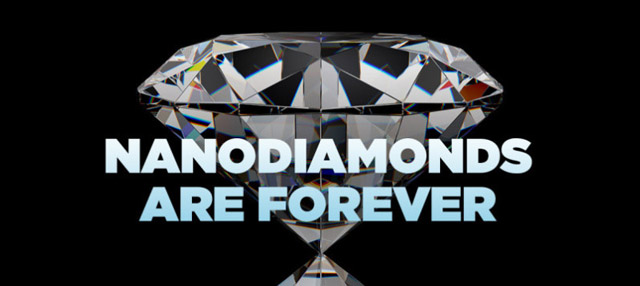No doubt you’re already familiar with the many ways graphene promises to save us all, but there’s another (so-called) miracle material out there vying for your attention — and it’s sparkly, to boot. Say hello to the latest and greatest substance to kick science’s arse straight into the future: the nanodiamond.
Of course, you can’t actually see any of these glittering gems, because at roughly five-nanometers-long (or about five billionths of a meter) nanodiamonds are invisible to the naked eye. But don’t be fooled by their small stature; nanodiamonds have everyone from electrical engineers to oncologists buzzing about the wildly exciting doors they can open for us. Here’s a look at all the ways they could make everybody’s lives just a little bit better.
What Are Nanodiamonds?
Though preposterously helpful they may be, nanodiamonds actually owe their entire existence to one of the most destructive forces mankind has ever wrought: nuclear warfare.
In 1963, three Soviet scientists at the All-Union Research Institue of Technical Physics were hard at work researching nuclear bombs. As you can see in the animation below, in order for a bomb to blow, the core (be it plutonium, uranium, etc.) needs to be squeezed hard and fast. The easiest way to make that happen? Explosives, of course.
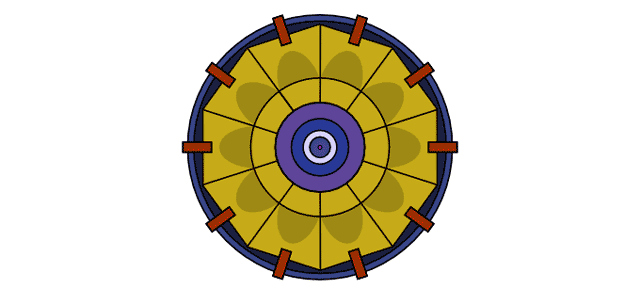
It just so happened that, in this case, our Soviet scientists used explosives that were carbon-based — you know, the same stuff diamonds are made from. They weren’t at all expecting what they found, though; the residual soot from the explosives was littered with diamond nanoparticles (ranging in size from 4-10 nm). Not much of an engagement ring, no, but all this microscopic bling opens up a world of possibilities more incredible than any rock could ever hope to be.
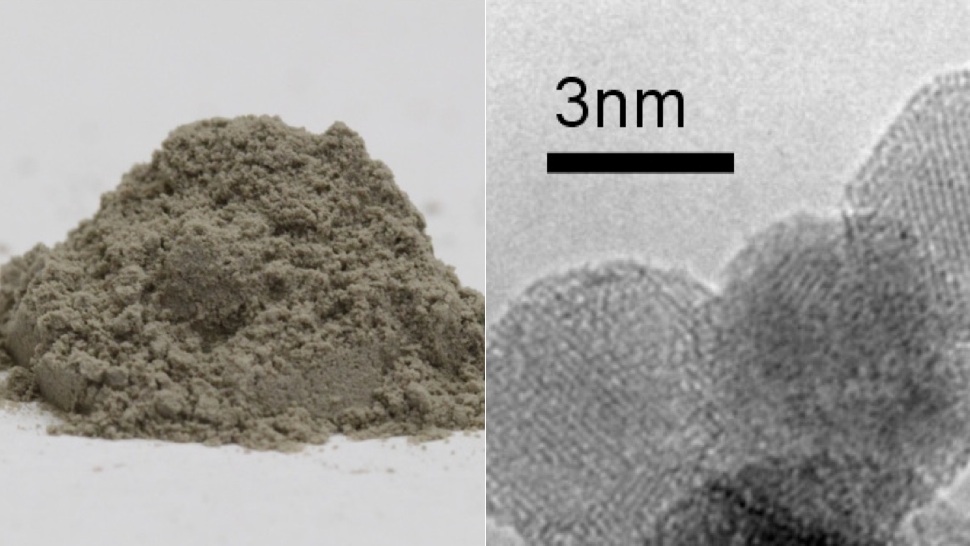
A pile of pure diamond nanoparticles actually just looks like agrayish-brown mound of dirt. Via
Nanodiamonds are, in their most base form, carbon-based particles that are roughly 4 to 5 nanometers in diameter and covered in facets reminiscent of a soccer ball, which is part of what allows them to create such intense bonds with such a variety of different molecules. But what makes them so crucial in the advancement of quantum mechanics, biotechnology, and any other number of fields might surprise you: It’s their flaws.
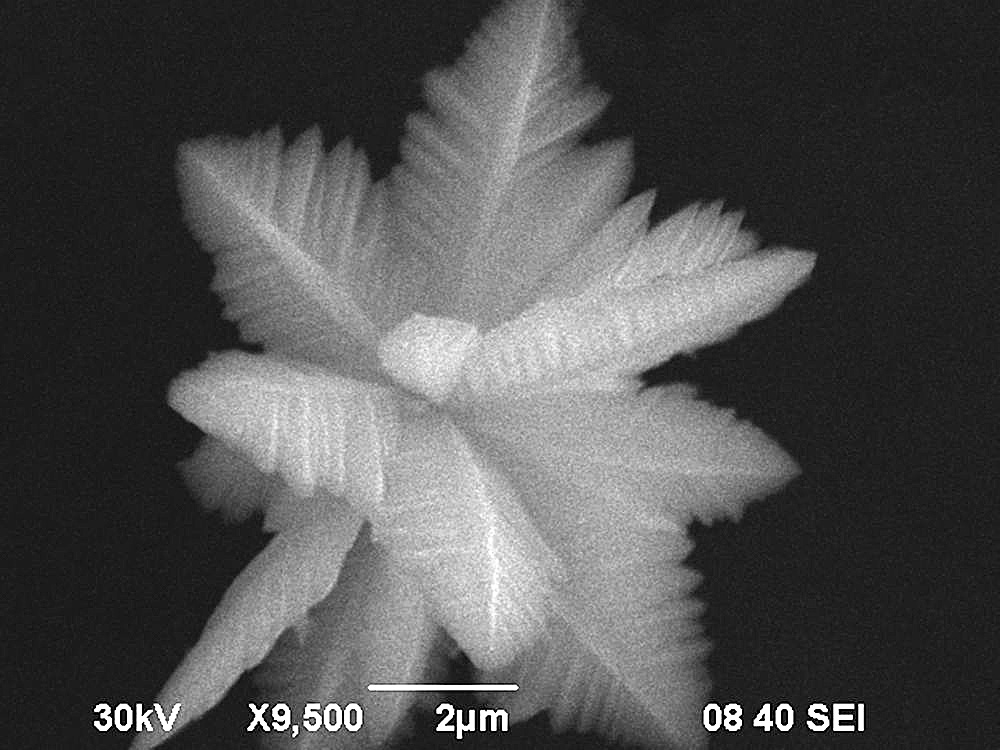
While any sort of colour in a diamond usually kicks its value down a notch, no one’s trying to buy or sell microscopic one based on the 4Cs. And in fact, a single, carefully controlled imperfection can give nanodiamonds an isolated colour center, which lets nanodiamonds function as single, trapped atoms, so relative to their size, they have huge surface areas that allow them to form strong bonds with a variety of other materials. What’s more, their non-toxicity means that nanodiamonds are perfectly suited to the many potential biomedical and mechanical uses just sitting at their sparkling fingertips.
A Bright Future
A Micro-Abrasive Additive
Diamond, being extremely hard and highly chemically stable, is one of the best abrasives in the natural world. Consequently, nanodiamond powder — which enjoys the abrasive qualities of diamond as well as the functional qualities of, well, powder — lends itself to creating highly effective polishes in the forms of paste, gels, etc., giving you the smoothest surfaces possible and opening up a world of potential.
While you can’t run out and pick up a tube of nanodiamond lube just yet, more and more commercial applications for these incredible little gems are being realised by the day. For instance, for the gearheads among us, the auto-mechanic world is starting to look to nanodiamonds as an ideal oil additive. In internal combustion engines, the particles act like microscopic ball bearings, reducing friction between the pistons and engine walls. The result? An increased oil lifetime, less wear on the motor itself, and better fuel mileage, to boot. But it doesn’t just stop at motors. Think of it as a futuristic WD-40 on crack.
Making Better Make-Up
Nanodiamonds have an unusually high absorption rate, so adding them to skincare products allows active ingredients to work at their peak potential. The nanodiamonds absorb more of the active ingredient than your skin would on its own, and as the nanodiamonds in turn penetrate the deeper layers of the skin, the active ingredient is carried with it.
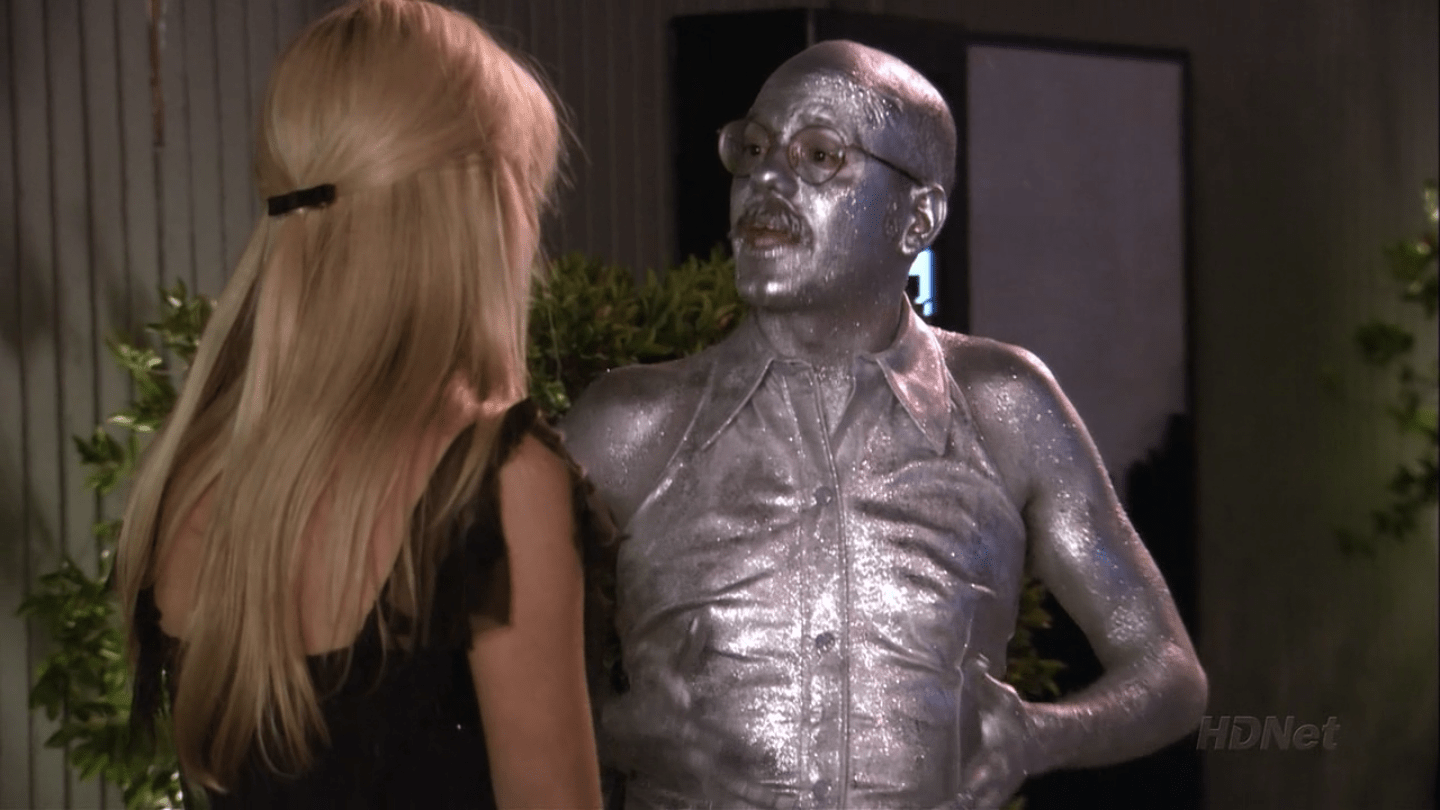
It’s not just the absorption of synthetic compounds that gives nanodiamonds a bright future in cosmetics. Nanodiamond molecules also form particularly strong bonds with water. So since any nanodiamond-based cream/lotion, in addition to being fully and rapidly absorbed by skin, would carry and keep water with it, it would keep skin hydrated for longer.
And though we have yet to see any actual, nanodiamond-laced beauty products on the market, the field is ripe with potential. Be it lotions, acne creams, or even prescription ointments, don’t be surprised if, one day soon, you find yourself walking down a drugstore aisle just dripping with diamond-based gunk to slather on your skin.
Kicking Cancer’s Arse
No chemotherapy is fully effective, but brain tumors — particularly glioblastoma — are particularly difficult to treat, because existing chemotherapy drugs have an incredibly difficult time passing through the legion of protective vessels, called the blood-brain barrier, that surround your brain. But even the drugs that do occasionally make it through rarely stay in the tumour long enough to have any significant effect. By attaching these drugs to nanodiamonds, though, the tiny molecules’ incredible absorption properties could do wonders for the fight against cancer.
The biggest plus in the nanodiamond column? They’re actually able to carry chemotherapy drugs through the blood-brain barrier and directly into the brain itself.

It gets better. Last September, researchers at UCLA’s Jonsson Comprehensive Cancer Center used rodents to develop a strategy that allowed them to create strong bonds between doxorubicin molecules (a popular cancer-killing drug) and nanodiamond surfaces. The result was the combination superdrug called ND-DOX.
While tumour proteins can send injected anti-cancer drugs out into the surrounding tissue before there’s any time for the drugs to actually kick in, they can’t deflect nanodiamonds the same way. So not only do the anti-cancer drugs remain in the tumour longer, they keep the body’s healthier tissue from being exposed, limiting any negative side effects.
During the UCLA experiment, the survival rate of the ND-DOX-injected rats had significantly increased compared to the rats that had been treated with the unmodified drug. Dean Ho of the UCLA School of Dentistiry, one of the scientists who worked on the study, said:
Nanomaterials are promising vehicles for treating different types of cancer. We’re looking for the drugs and situations where nanotechnology actually helps chemotherapy function better, making it easier on the patient and harder on the cancer.
A Different Kind of Diamond Grill
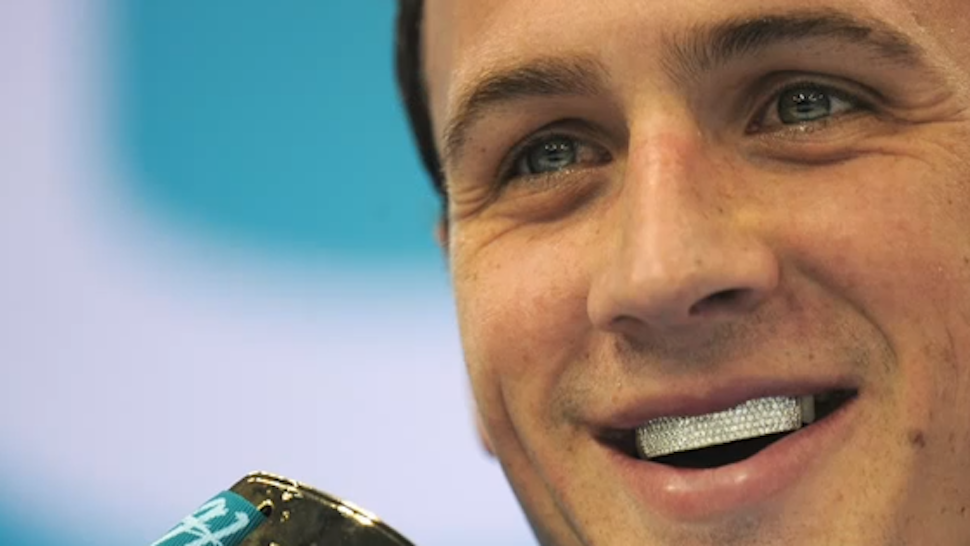
But chemotherapy isn’t the only condition Ho and his team plan to treat with nano diamonds. The next place they will be heading is our mouths.
During jaw and tooth repair operations, doctors are normally forced to use invasive surgery to stick a sponge full of bone-growth-stimulating proteins near the offending area. And although effective, these surgeries tend to be expensive, time consuming, and like most invasive surgeries, pretty painful. But that all might change soon thanks to another Ho-led study.
This time out, the team found that nanodiamonds “bind rapidly to both bone morphogenetic protein and fibroblast growth factor,” both of which essentially encourage bone and cartilage to rebuild themselves. What’s more, the itty bitty diamonds’ large surface area means the proteins can be delivered over a longer period of time — not that getting them there in the first place will be a problem. All it takes to enjoy the benefits of these shiny tooth-savers is a simple injection or oral rinse. No invasive surgery required.
Fast Optical Processing…
There are ample applications outside of the medical realm as well. Currently, optical transistors (flow regulators that operate the same way on light beams that electronic transistors operate on electrons) are created using special dye molecules. But since these types of optical devices are only able to operate at extremely low temperatures, any practical use outside of a lab environment was more or less out of the question. And that’s pretty unfortunate, because optical signal processing has the potential to be significantly faster than traditional transistors — assuming they could function at room temperature.
A research team at the Institute of Photonic Sciences in Barcelona, though, may have finally found a way to make optical processing a viable consumer technology. The transistor mainly consists of a single, powerful green laser focused onto a nanodiamond containing a single nitrogen vacancy, which is basically a defect in a single atom of what would otherwise be a microscopically perfect carbon crystal pattern.
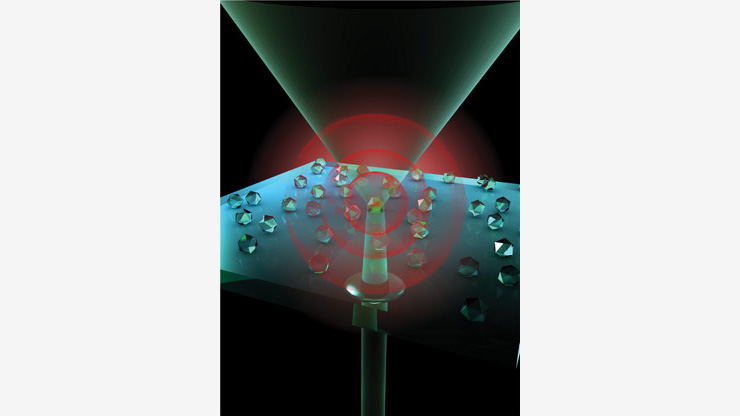
When in an “on” state, the green laser would be transmitted through the diamond, but to turn the transistor off, they would shine an additional, near-infrared laser onto the crystal, changing the way the green light would be affected by the nitrogen vacancy. By stacking a bunch of nanodiamonds together and creating light guides for the lasers, you’d be able to start creating logic gates and, ultimately, full integrated circuits that run on light instead of electricity.
So how is this any better than current optical processors that use dye molecules? The nanodiamond ones work at room temperature. A virtual game changer and the thing that could make optical processing actually work in any practical sense. And all this could be little more than a decade away.
…And Even Faster Quantum Computing
One specific type of center has proved particularly exciting in terms of the recent crop of potential applications: the negatively charged nitrogen-vacancy center. Catchy, no?
According to the MRS Bulletin:
Much of the motivation for exploring nitrogen-vacancy (NV) centres in diamond in the past decade has been for their potential as a solid-state alternative to trapped ions for quantum computing. In this area, the NV center has exceeded expectations and even shown an unprecedented capability to perform certain quantum processing and storage operations at room temperature.
Basically, current quantum computers are able to work at incredible speeds, yes, but one of the the trade-offs is that ions processing the information are highly fragile. We’ve been able to get around this by cooling these ions to near absolute zero (which minimizes exposure to the thermal noise that could destroy them), but that sort of environment is incredibly impractical to maintain. NVs, though, are far less temperamental than trapped ions, meaning they could very well give us the power to build quantum computers that work at room temperature.
What’s more, incredible as all this potential may seem, gaining access to these properties really isn’t that expensive. To observe the phenomenon, scientists need nothing more than a laser, microscope, radio-frequency power supply, and an avalanche photodiode, which is a highly sensitive semi-conductor that converts light to electricity.

There are several different ways to produce the NV centres, and each comes with its own benefits and drawbacks. Which one you choose depends almost entirely on what you’re planning to do with your teeny tiny bits of diamond dust. Because believe us — you’ve got plenty of options.
Better Biological Sensors
According to Professor Tanja Weil, director of the Institute for Organic Chemistry III, Univeristy of Ulm:
Standard blood tests do not capture — as one might expect — free iron ions in the blood, because free iron is toxic and is therefore hardly detectable in blood.
Instead, when testing for iron levels, current methods rely on the proteins responsible for the storage and transport of iron — not the iron ions themselves — such as the protein Ferritin, which can contain up to 4,500 magnetic iron ions. These proteins are then counted using estimates and immunological techniques, meaning that, since doctors are stuck using such an indirect method, results can be pretty inconsistent. And that can be a major problem!
As it stands now, this means we’re more or less just making educated guesses on patients’ potential for contracting conditions relating to iron-deficiency (like anemia) or high levels of iron, which would signal some sort of acute inflammatory response. The Ulm scientists, however, have developed a method for going straight to the source and measuring Ferritin directly, allowing illnesses to be detected sooner and far more accurately.
In utilising nanodiamonds along with their inconsistencies (the tiny flaws prevent them from being perfectly colorless and transparent), Professor Fedor Jelezko, director of the Ulm Institute of Quantum Optics explains how his successfully developed technology sensitive enough for the task:
These colour centres allow us to measure the orientation of electron spins in external fields and thus measure their strength. We [absorbed ferritin on the surface of the diamond] with the help of electrostatic interactions between the tiny diamond particles and ferritin proteins. Theoretical modelling was essential to ensure that the signal measured is in fact consistent with the presence of ferritin and thus to validate the method.
From here, the Ulm team will eventually be able to determine the precise number of ferritin proteins as well as the average iron load of each individual protein. What’s more, the possibilities this holds for other medical diagnostics techniques seems nearly limitless.
And this is just the beginning; hardly a day goes by without someone discovering some new, novel technique for these (at least until now) relatively unknown miracle gems. But rest assured, it won’t stay that way. With all the potential for good being realised, it won’t be long before nanodiamonds are on the tip of everyone’s tongue — literally and otherwise.
[Ray Techniques Ltd, Science Direct, UCLA, Medline Plus, Phys.org 1, 2, Optics and Photonics News, Azonano.com, Instruments in Education Development]
Picture: Russian Journal of Applied Chemistry, Nanometer.ru, Lehigh.edu, Macquarie University, UCLA, Adamas Nano, Sustainable Nano
